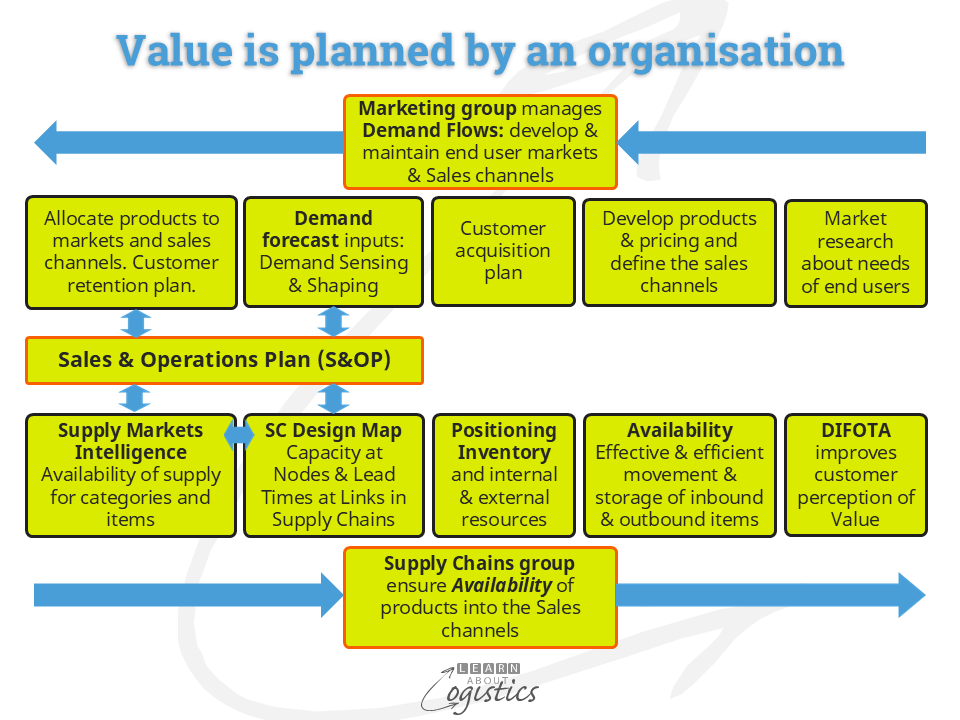Of Value
Value is something that most people in business expect when buying products and services. At the corporate level, the thoughts are about monetary value. But it is also necessary to think of value in a sense of being beneficial or useful. And this is an important role for a Supply Chains group when, for example, providing ‘in-full and on-time’ delivery of customer orders.
Corporate level Value
Financial value is added when the form of purchased materials and components are changed to produce a product for sale. But businesses that only sell finished goods add value by gaining placement of a product on a retail shelf. Value Added (VA) measures the contribution to the business by all employees, through their knowledge, imagination, effort and skills, recognising that ‘people add value and technology reduces costs’. Below is a Value Added Statement:

The two columns indicate that the VA Statement uses the same numbers as the Corporate Income Statement, but presented in different formats. The Value Added Statement column shows that Value Added is calculated as the sales value of products (net of payments for royalties, licences etc.), less the total spend in Supply Markets for purchased items and supplied services.
The Value Added is distributed to four stakeholder groups engaged in operating the business. The VA Statement enables management and staff to know how the Value Added ‘cake’ is divided, which can lead to some interesting conversations!
- ‘Employee share’ is the total cost of employing all staff, including benefits such as executive bonus and non-wage costs such as subsidised meals and children’s creche
- ‘Owners and Organisation share’ to legally establish, maintain and grow the business. Dividends paid to investors
- ‘Finance share’ is the money paid to financial firms as interest on borrowings
- ‘Governments share’ paid to central, state and local governments. Corporate tax, sales tax, property tax, excise duty etc.
The Supply Chain costs for a business comprises the total:
- spend in supply markets on physical items and services;
- cost of goods storage and movement facilities and
- cost of Supply Chains group employees
This cost is an investment in building effective relationships with suppliers and customers. Improved value for customers and expectations for suppliers is delivered through enhancing processes that enable a better response with reduced time.
Supply Chains group and Value
To maximise the Value Added for a business requires an effective Sales & Operations Plan (S&OP) process in the business. This co-ordinates the Marketing and Supply Chains groups to link the Demand Flow and Supply Chains, as shown in the diagram below.

The Aim of a Supply Chains group (Procurement, Operations Planning and Logistics), is to provide Value for the end user. As the price, delivery and payment terms have been agreed between the customer and Sales, value is viewed by the customer as ‘Delivery in Full, On Time, with Accuracy’(DIFOTA). To achieve a high probability of DIFOTA requires the Supply Chains group’s Objective to provide Availability of goods and services that are sold through the organisation’s sales channels.
To provide Availability of products for the sales channels, inventory is used to decouple demand and supply and also to enable responses to unplanned events. But this action can incur substantial holding costs, that may affect working capital. The management of Inventory, comprising: inventory policy, planning and control and the necessary quantitative analysis is an important role for the Supply Chains group.
To assist the planning process, supply chains professionals develop the Supply Chains Network Design Map. This is structured from Tier 1 suppliers through to their suppliers’ suppliers and from Tier 1 customers through to their customers’ customers, using data and information about supplying and receiving locations (Nodes) and the Links between. Attached to the Design Map is the Supply Markets Intelligence document, which provides the current status concerning the organisation’s supply markets.
The Design Map incorporates definitions and structures within techniques promoted under the concept of LEAN and its predecessor, Just in Time (also called the Toyota Production System – TPS):
- Value Network: identifies the business and technical resources within and between supplier and customer businesses (Nodes). Between Nodes are Links, which are interactions concerning deliverables – either tangible products and money, or intangible data and information.
- Value Chains provide a macro-level view of operations in a business and how value flows through processes, from sourcing, through production, then sales to customers and disposal. Value Chain Analysis is used to evaluate Value Chains
- Value Streams focus on specific business processes and operational activities required to design, supply, produce, and deliver a product or service to customers. Value Stream Mapping is a technique used for evaluating Value Streams
Marketing is able to generate demand and create value for end users through the Demand Flow of processes. The needs of end users are identified through Market Research; then the step to develop products and define sales channels; and to construct a plan for acquiring customers. Prior to release of the product(s) and afterwards, sales forecasts are published that use external data concerning the potential market (Demand Sensing) and sales channels (Demand Shaping), which includes promotional pricing, advertising and customer incentives.
The Sales & Operations Plan is a structured, tactical level process that provides a forum for cross-group collaboration between the Marketing and Supply Chains groups. The objective is to improve the future balance between the market demand in sales channels, company resources and the supply of materials and services.
Challenges in the S&OP process involve four critical elements of Supply Chains: supply, lead times, capacity and inventory. Each Node and Link in the Network of a business responds to an unplanned event in its own way, to protect their business. This makes for complexity, and the more Nodes and Links in the Network, the more complex the system. To better identify and reduce risks associated with complexity, variability and constraints in the Network and to reconcile differences, requires that the four elements are the responsibility of the unified Supply Chains group.
The need to provide value for customers and end users requires that S&OP is an essential and integral part of business operations. The output from the process enables the Supply Chains group to ensure that sufficient products and service parts are available to serve current and prospective customers from facilities that are correctly located.

